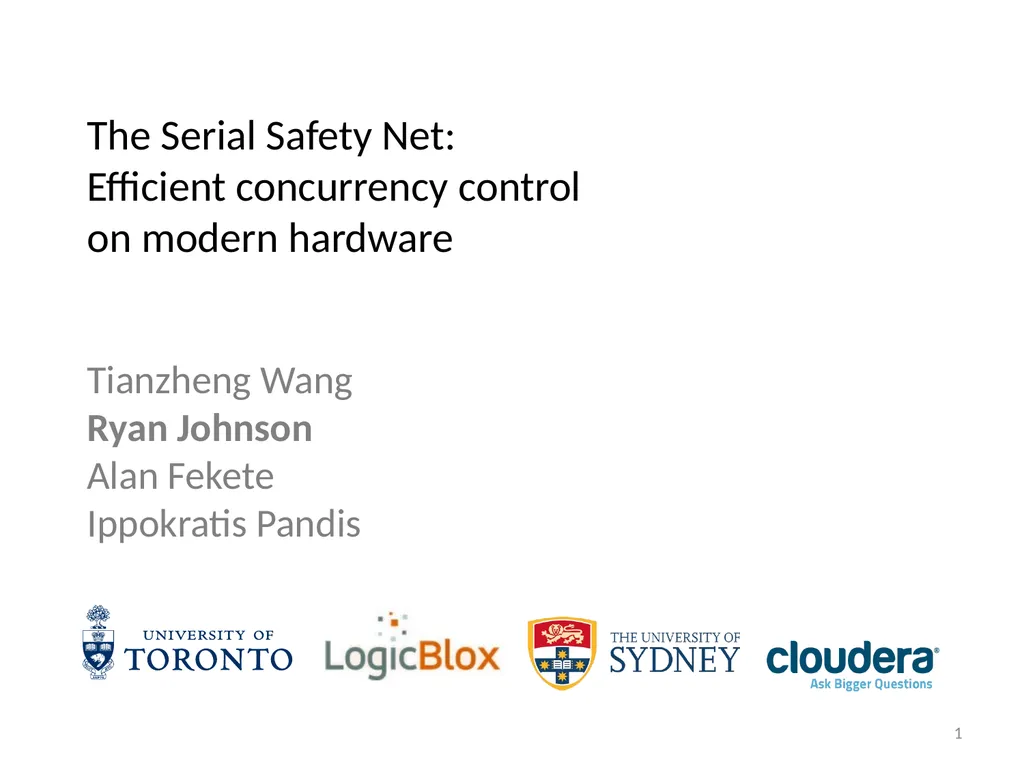Tianzheng Wang Ryan Johnson Alan Fekete Ippokratis
Author : myesha-ticknor | Published Date : 2025-05-10
Description: Tianzheng Wang Ryan Johnson Alan Fekete Ippokratis Pandis The Serial Safety Net Efficient concurrency control on modern hardware 1 Modern HW CPU on critical path 2 Low parallelism Focus hide IO stalls Classic DBMS Modern DBMS High
Presentation Embed Code
Download Presentation
Download
Presentation The PPT/PDF document
"Tianzheng Wang Ryan Johnson Alan Fekete Ippokratis" is the property of its rightful owner.
Permission is granted to download and print the materials on this website for personal, non-commercial use only,
and to display it on your personal computer provided you do not modify the materials and that you retain all
copyright notices contained in the materials. By downloading content from our website, you accept the terms of
this agreement.
Transcript:Tianzheng Wang Ryan Johnson Alan Fekete Ippokratis:
Tianzheng Wang Ryan Johnson Alan Fekete Ippokratis Pandis The Serial Safety Net: Efficient concurrency control on modern hardware 1 Modern HW: CPU on critical path 2 Low parallelism Focus: hide I/O stalls Classic DBMS Modern DBMS High parallelism Focus: minimize cycles Main-memory OLTP: more pressure on CC Locks Disks Threads Memory Disk Threads CC: current state of the art OCC (fast) SI (non-serializable) SSI (slow) OCC looks good. What’s the problem? Contentious TPC-C variant 24 16 6 12 1 3 CC: Robustness matters! 4 OCC (unfair) SI (non-serializable) SSI (slow) Need all three: fast, fair, serializable 24 16 6 12 1 Contentious TPC-C variant with retries The Serial Safety Net (SSN) 5 Some CC >= RC SSN Serializable execution Might admit anomalies Cheap certifier Works even if CC is buggy Aborts offenders Dictates access pattern SSN: fast, fair, serializable 6 OCC SI SSI SSN Database model 7 R1 R2 R3 R4 ... R3 Uncommitted write Invisible to other readers Multi-version database R1 R1 CC decides which version to read Captures most CC schemes, incl. 2PL Serialization graphs and cycles T1 r:y:w T2 w:x:r T3 r:x:w T1 8 SI read-only anomaly T3 T2 T1 (T3) commit time dependency order Serialization graphs and cycles T1 commits last & “closes” the cycle “Hard” to detect T1 … T3 “Easy” to detect T3 T1 SSN: efficiently detect T1 … T3 9 SSN in a nutshell 10 Define π(T) = min {c(S) : T … S} Define c(T) = “commit time of T” Forbid $P T : π(T) ≤ c(P) ≤ c(T) Track T’s earliest successor P might be a successor of T T might close a cycle Visualizing SSN 11 Exclusion window satisfied commit time dependency order Evaluation System 4 x 6-core Xeon @ 1.8GHz, 64GB DRAM A variant of Silo* that supports SI and RC TPC-C w/ random warehouse selection RC, SI, OCC (Silo), SSI, {SI, RC} + SSN What to test General performance/scalability Fairness for updates vs. reads Robustness under retries 12 * Tu et al, “Speedy transactions in multicore in-memory databases”, SOSP`13 SSN performs well 13 Higher is better SSI OCC Low implementation overhead SSN has low abort rate 14 Lower is better OCC SI (higher) and RC/SI+SSN SSI SSN allows more valid schedules than SSI or OCC SSN provides “safe retry” 15 OCC SI (highest) and RC/SI+SSN SSI Higher is better SSN is fair 16 SSI starves writers














